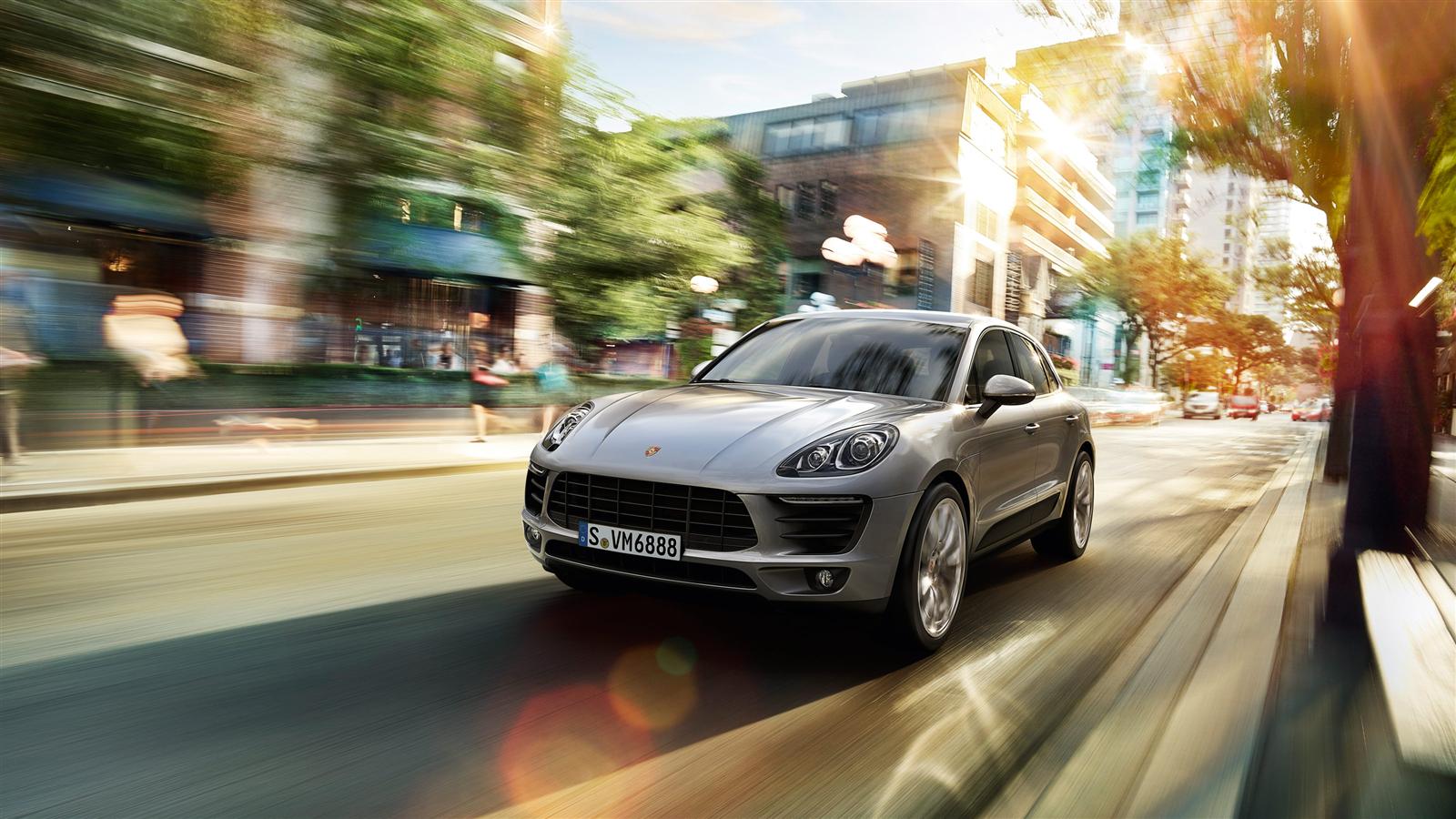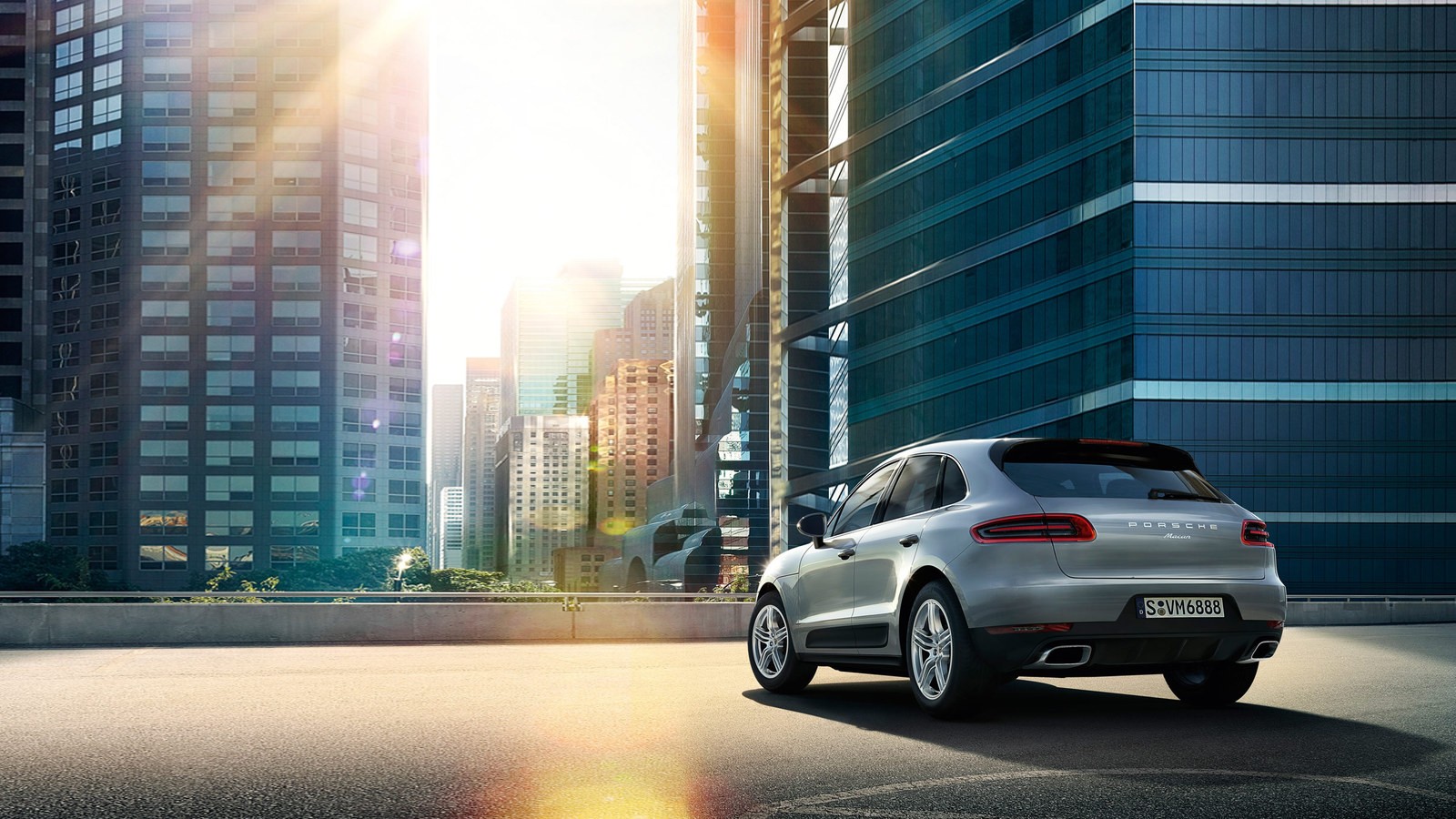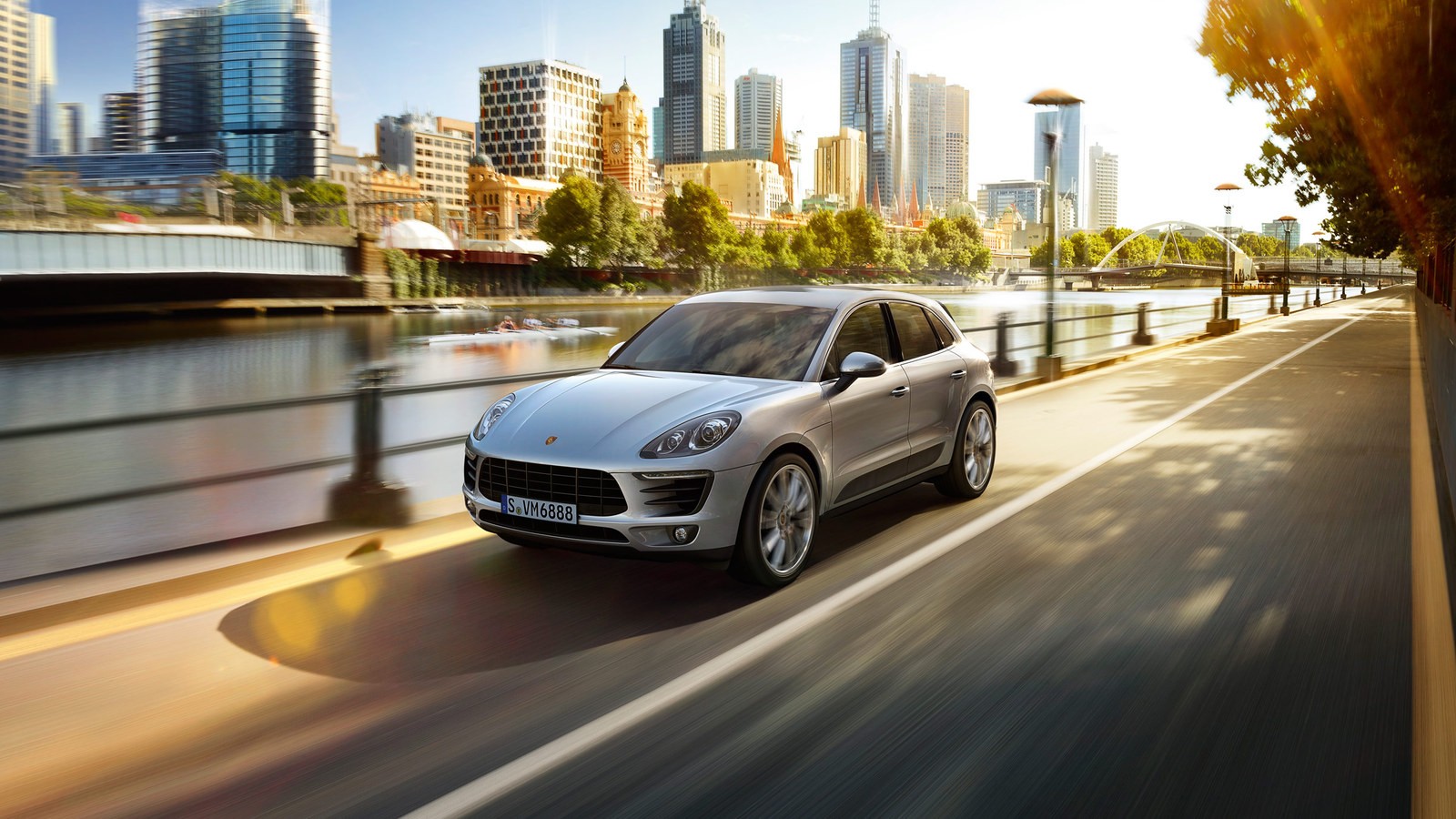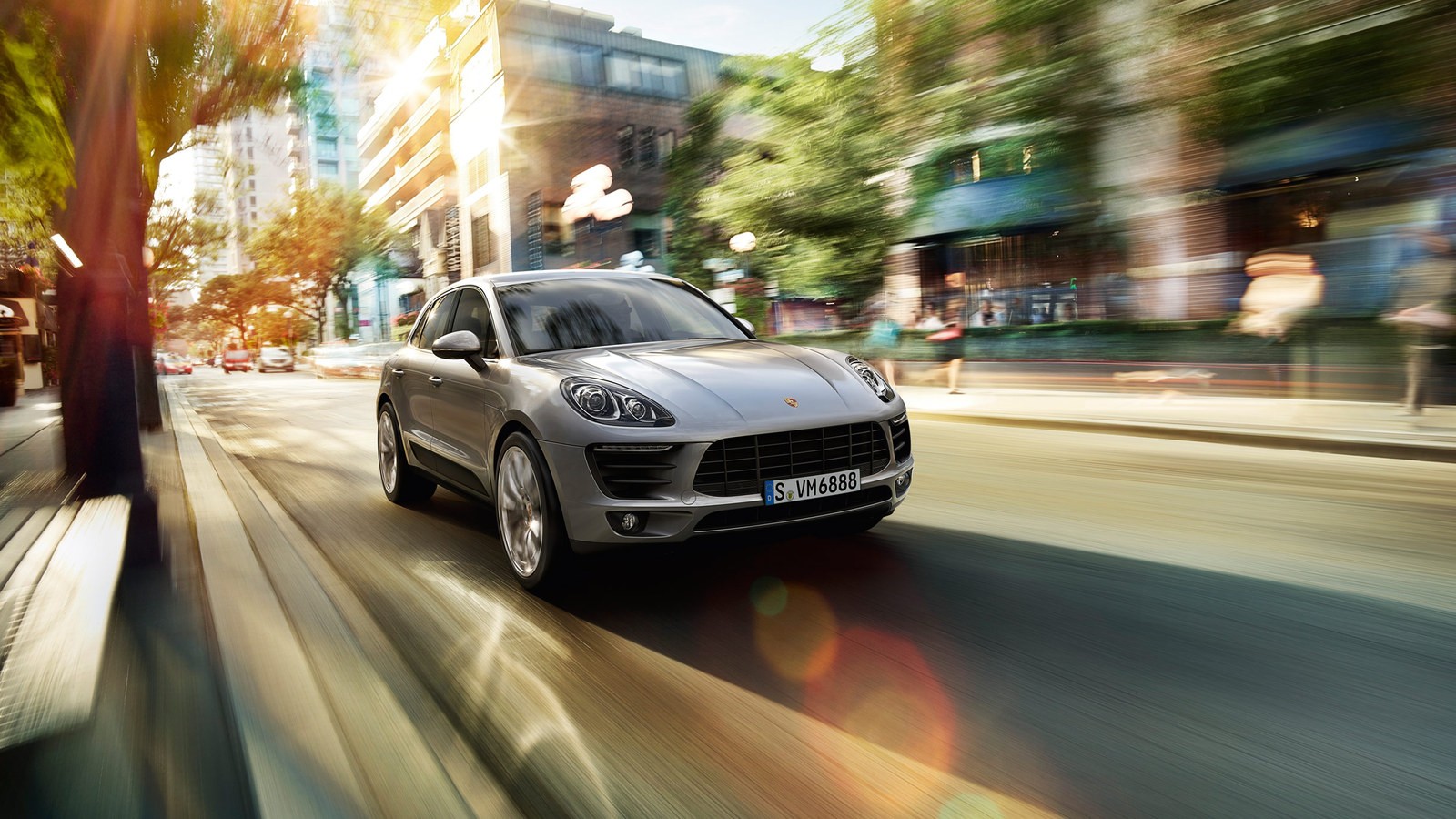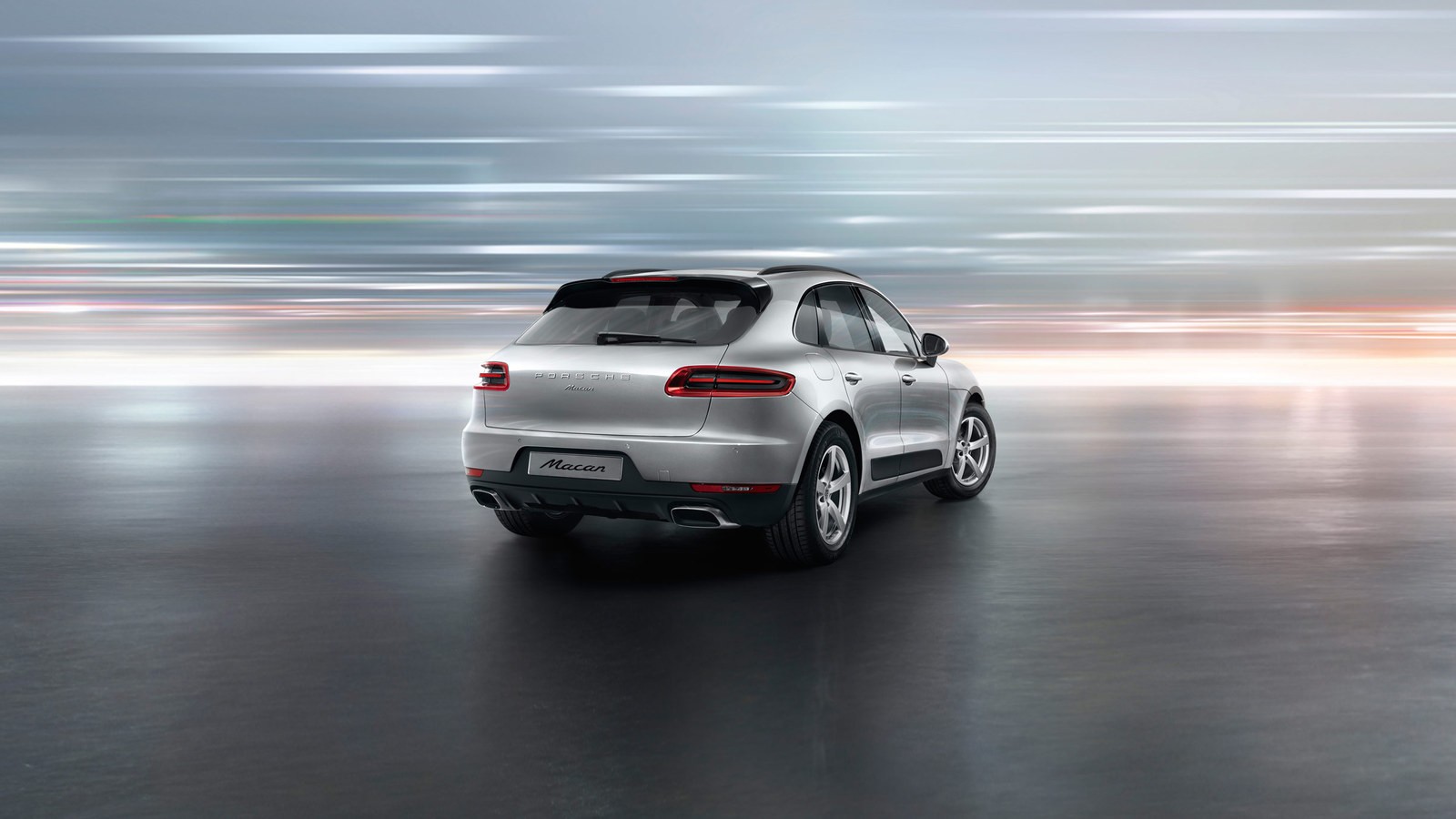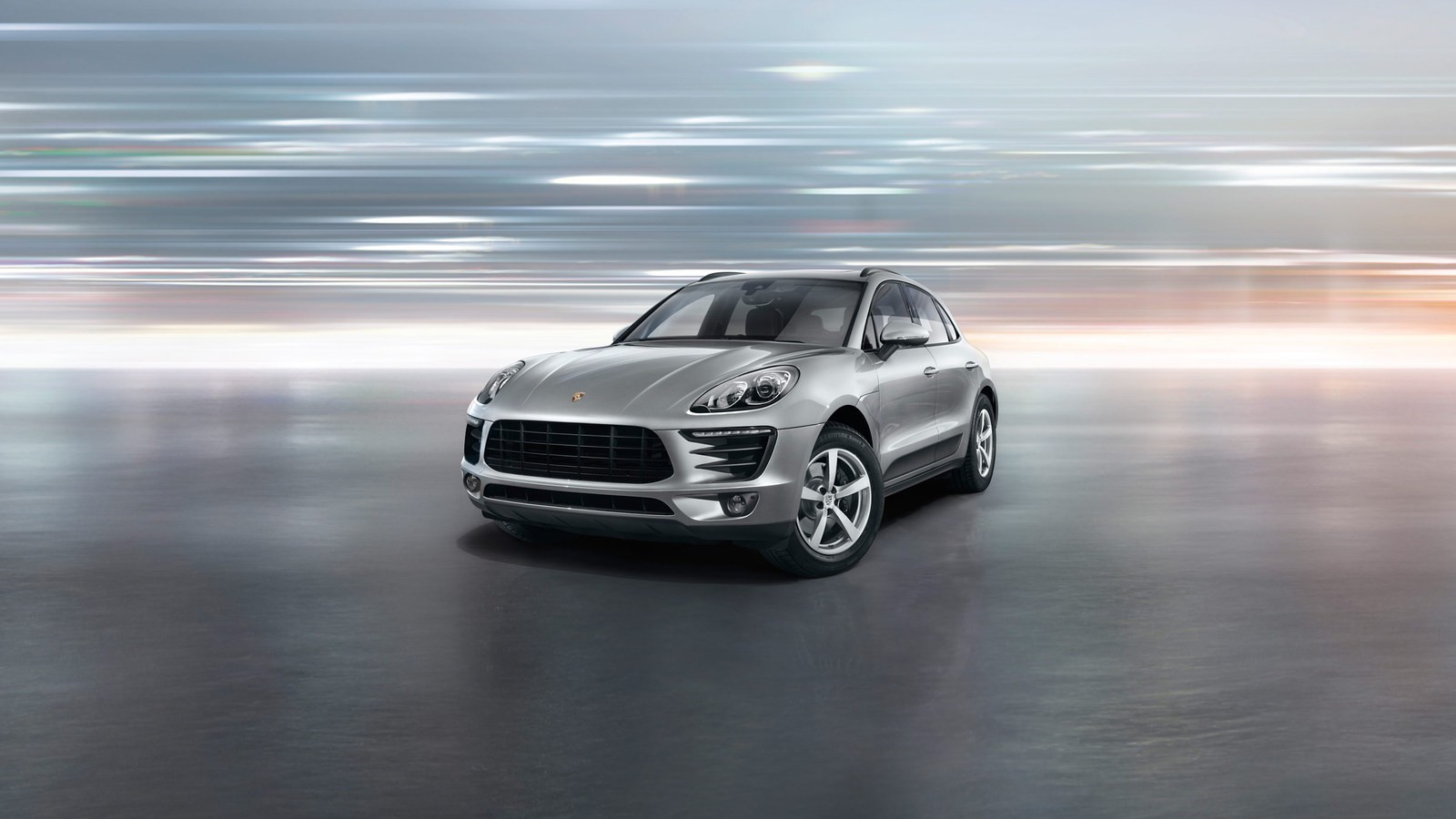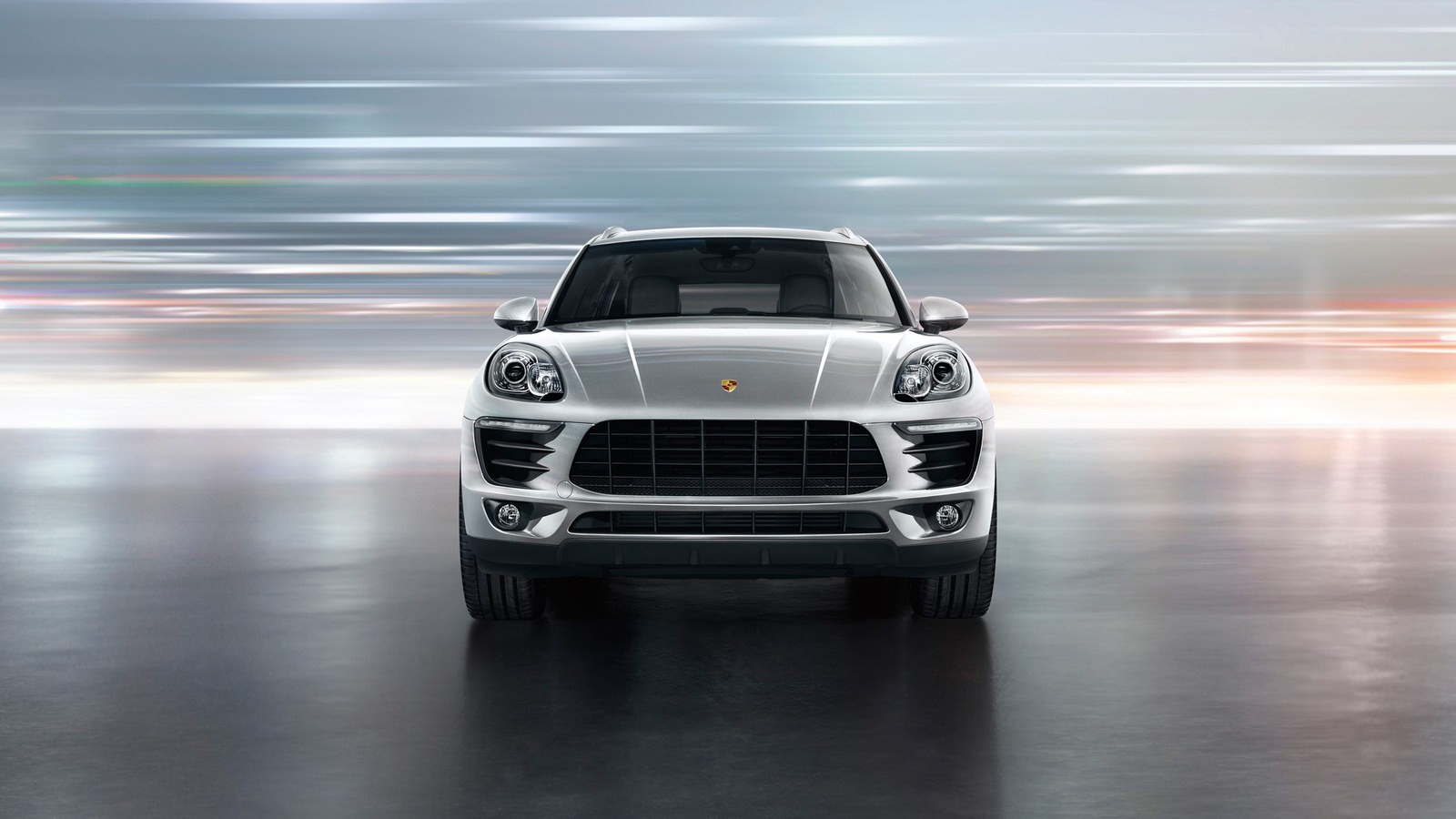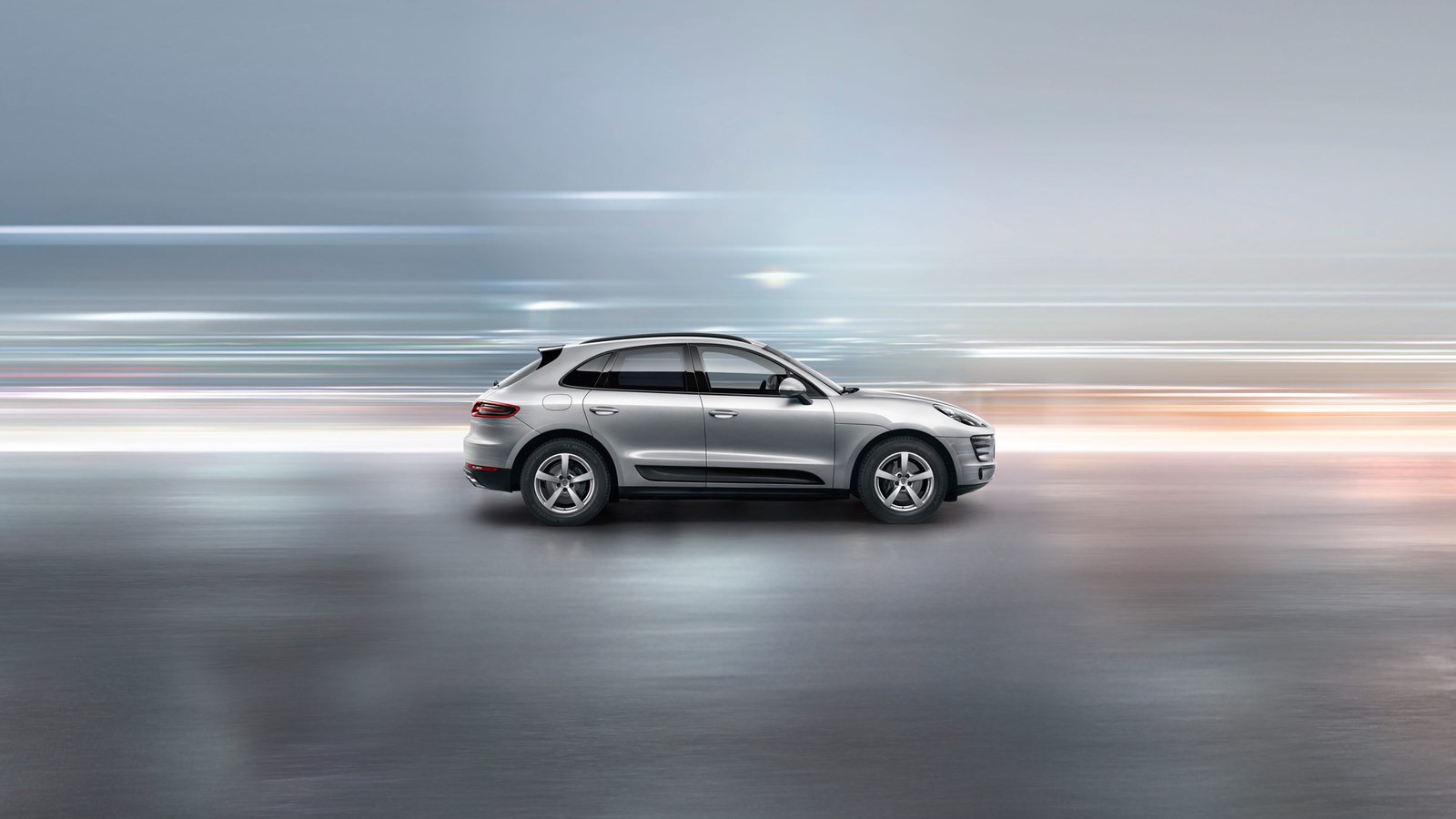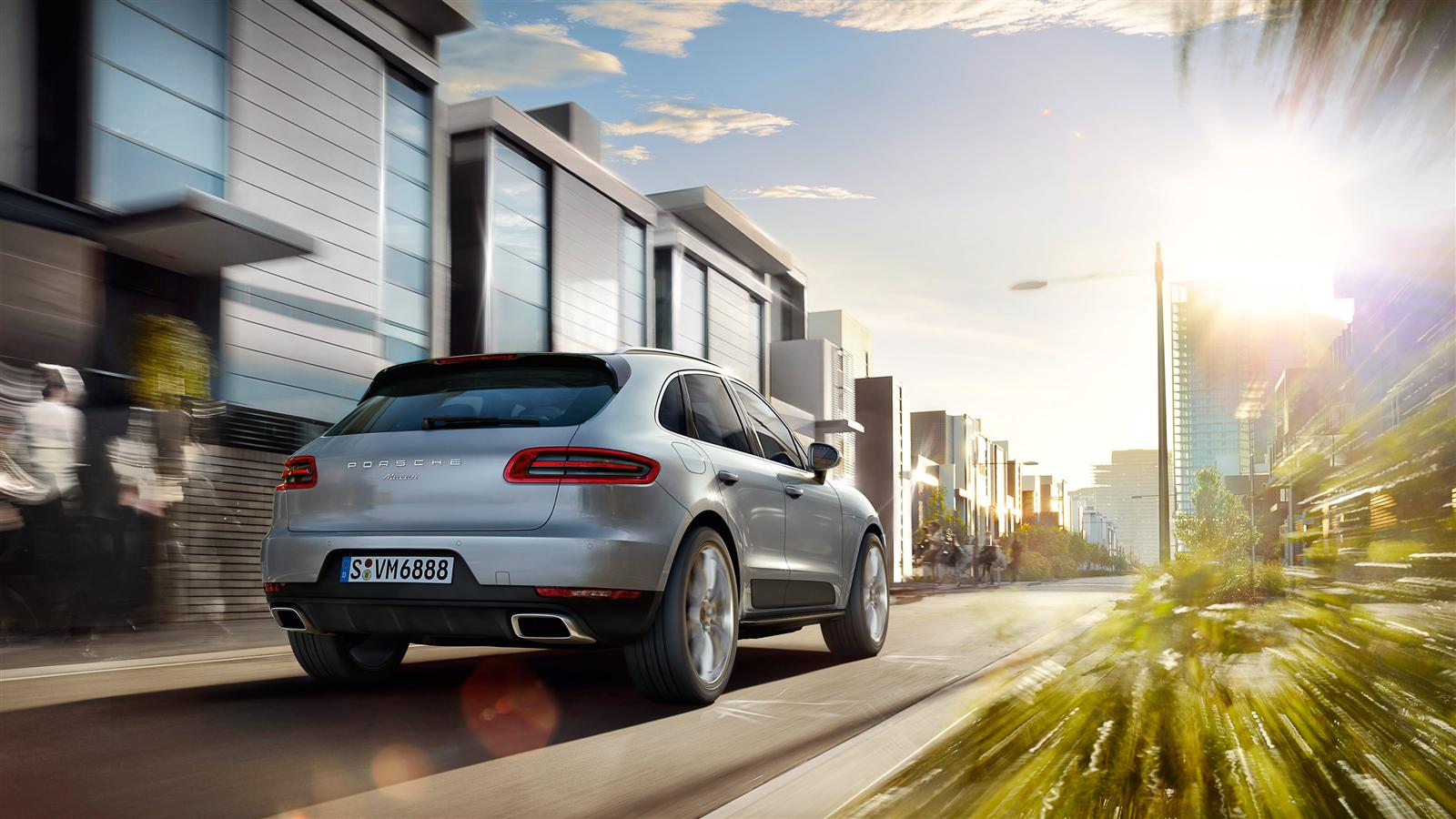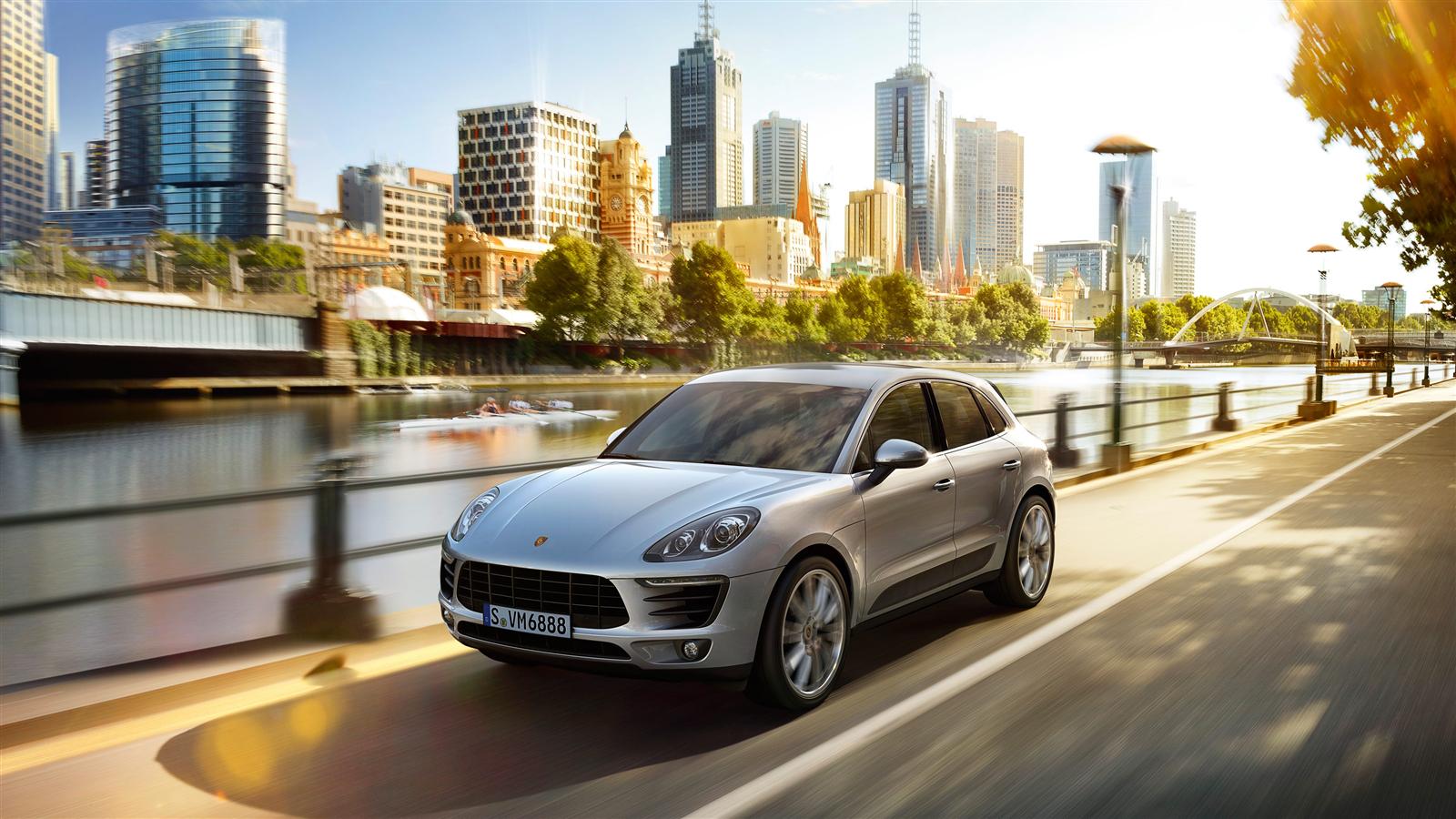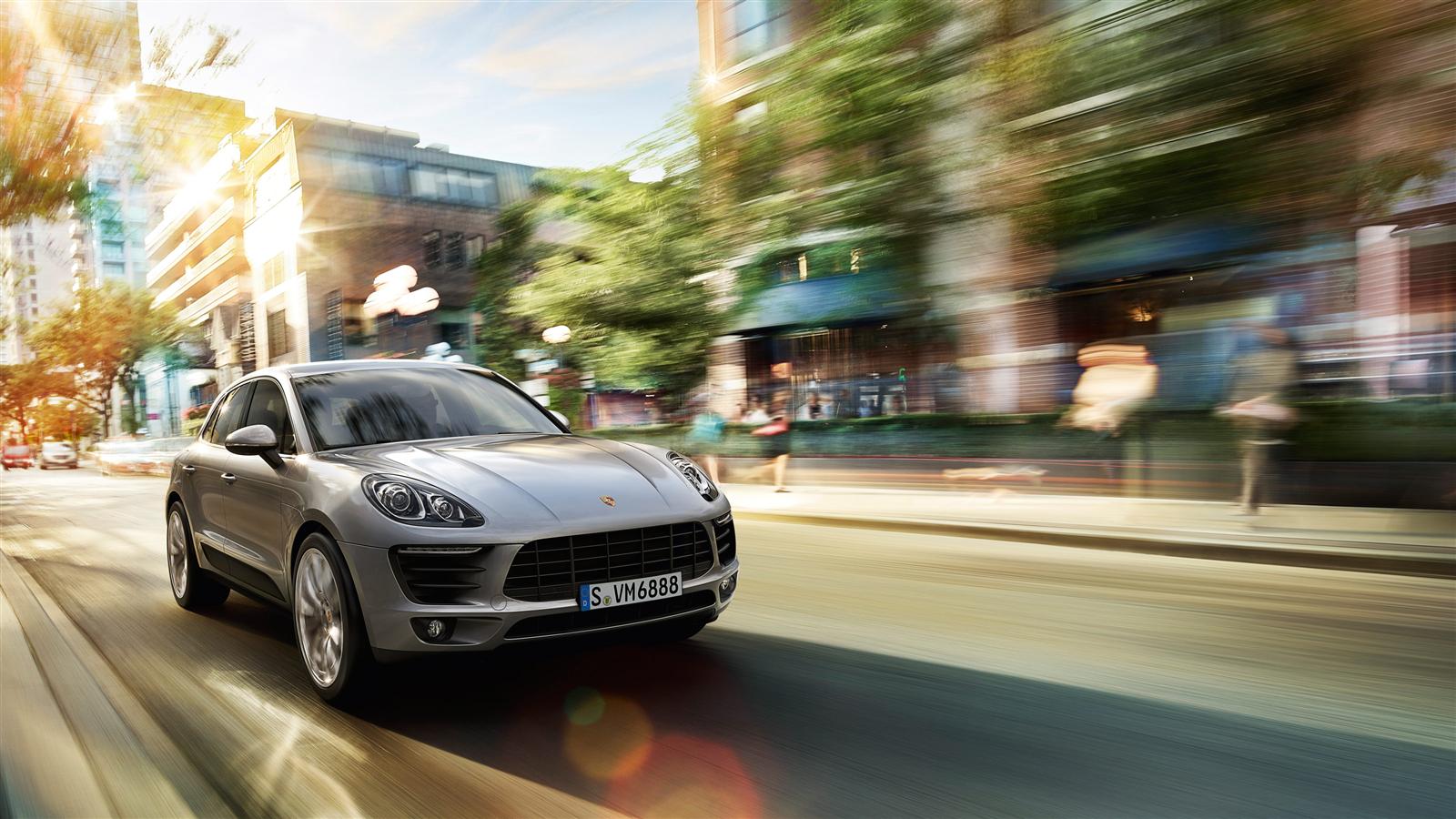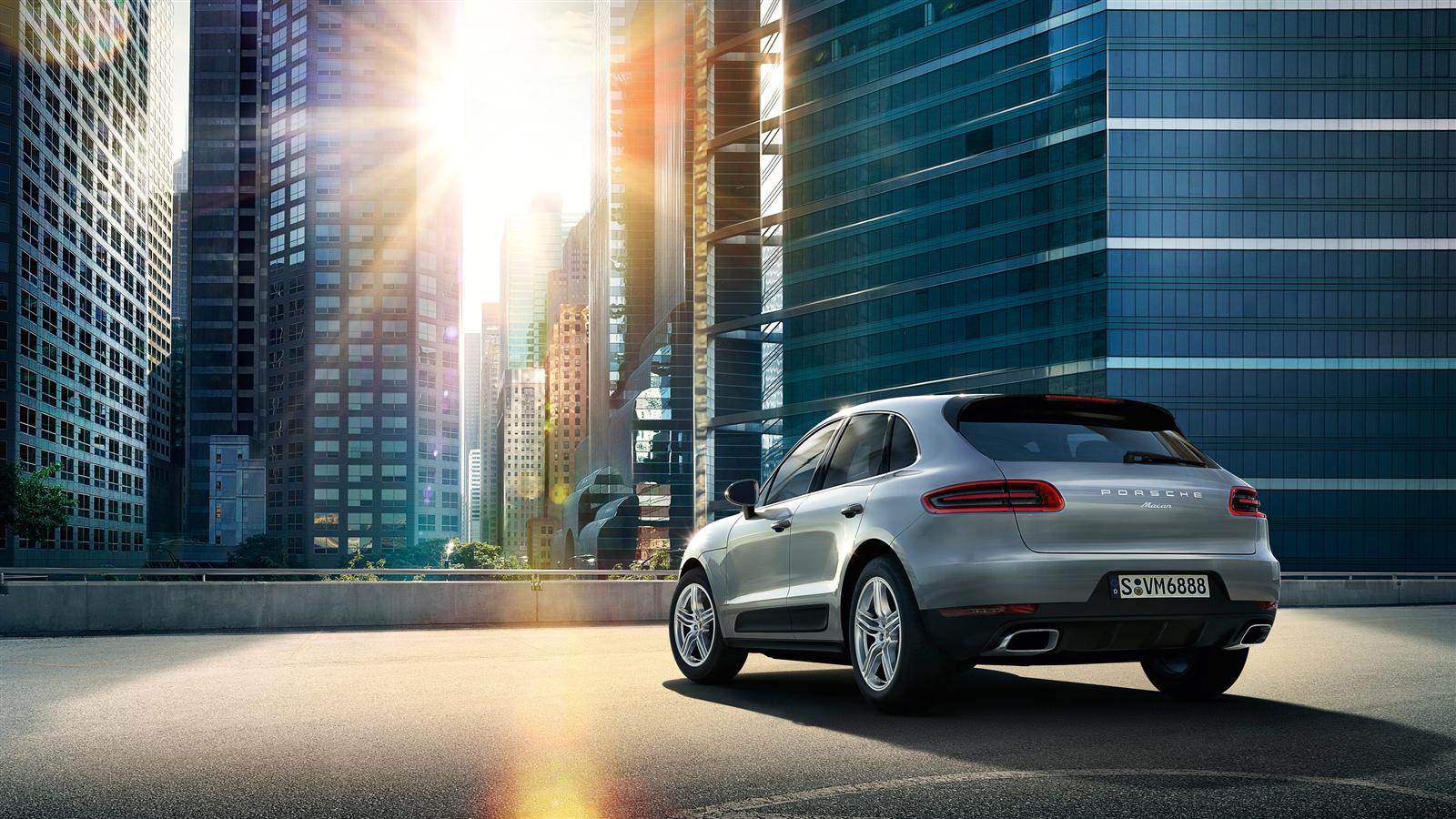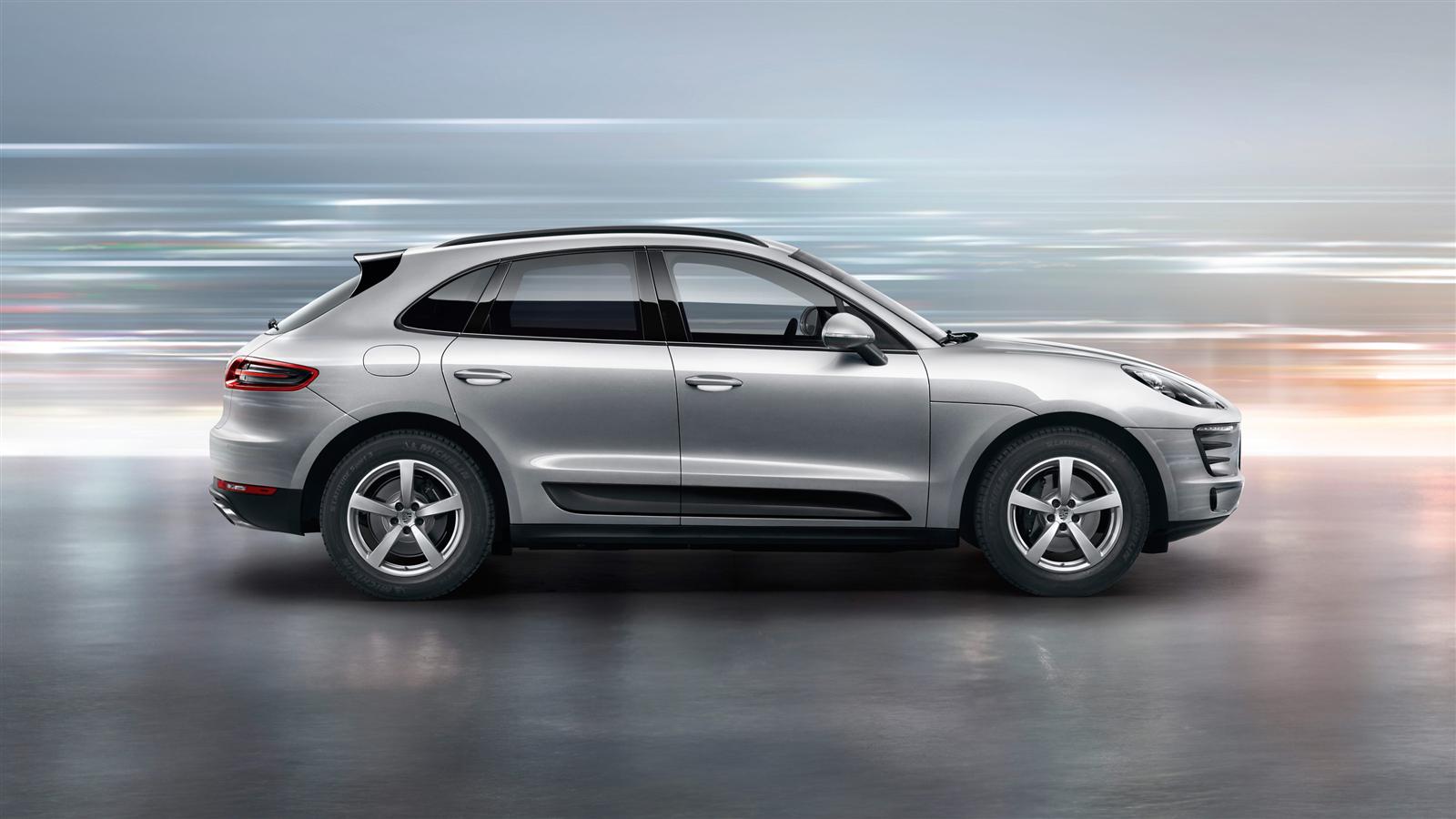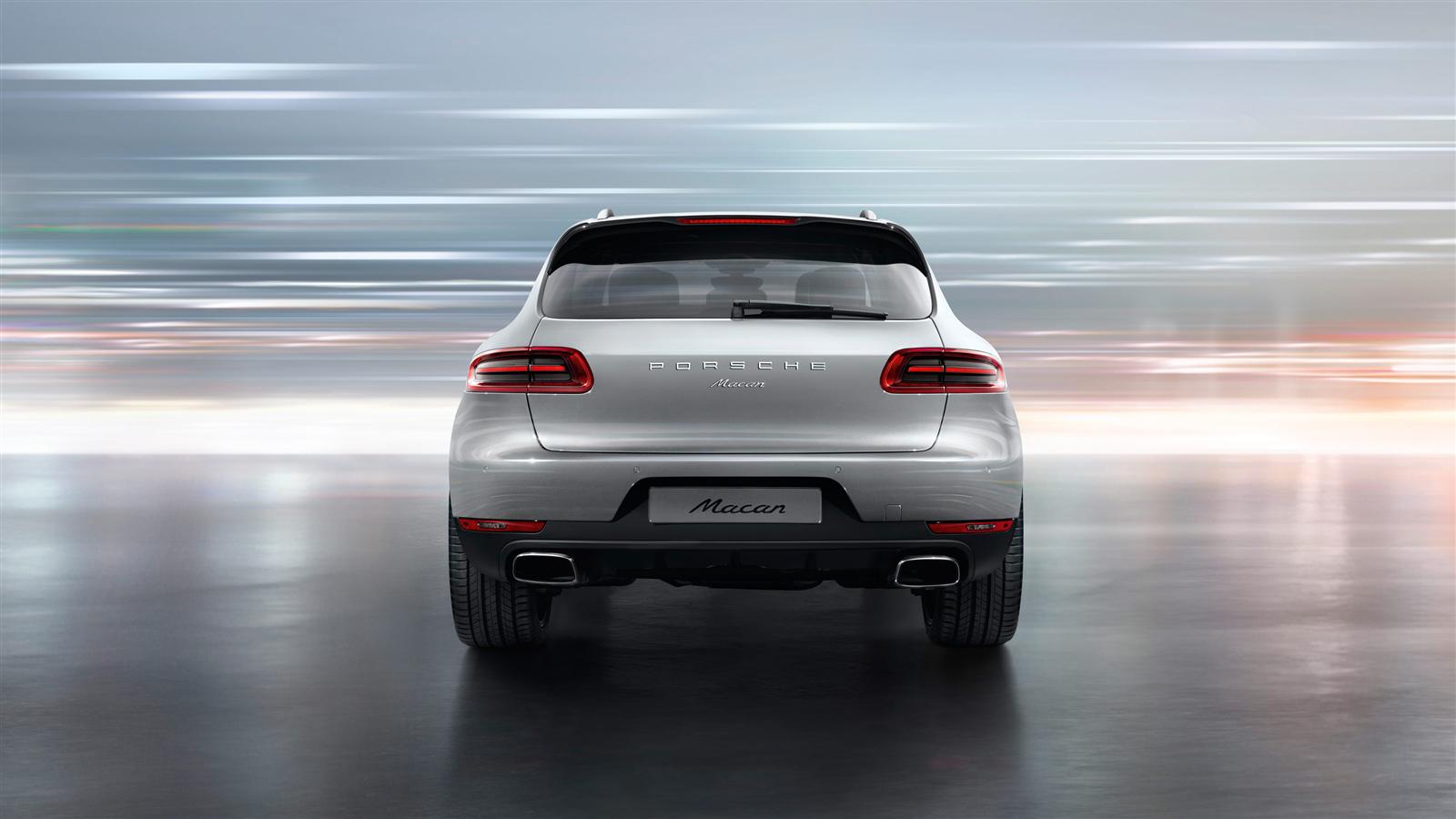(2017 – 2018) Porsche Macan (Base) – Ultimate Guide
After the initial Macan launch in Macan S, Macan Turbo and Macan Diesel model variants, Porsche subsequently released a base Macan for select Asian markets and the United Kingdom. Using a reworked version of the Volkswagen Group’s 2.0-litre inline-four EA888 Gen 3 engine used in multiple applications such as the Audi Q5. This engine became offered globally for the Macan’s 2017 model year following an announcement in March 2016.
The base Macan featured this 2.0-liter inline-four turbocharged engine delivering 252 hp, just enough grunt for the lightweight Porsche SUV. The car was fitted with a standard active all-wheel-drive system with an electronically controlled, map-controlled multi-plate clutch. That AWD system was fitted on all Macan models. A seven-speed double-clutch transmission transfers power as required and almost without any interruption in power supply, enabling the vehicle to accelerate from 0 to 100 kph (0-62 mph) in 6.2 seconds. There was no manual version available for the Macan.
From the outside, the base Macan looked similar to the Macan S. The interior had room for five, but mostly for four people. The infotainment system can be connected only with Apple CarPlay, but not with Android Auto. The dashboard resembled some of the Porsche models, especially the Cayenne. Despite its short wheelbase, it offered enough legroom for the rear passengers. The seatback was split and folding so it could expand and offer more trunk space.
Pictures
Press Release
Porsche is expanding its range to include a whole new class of vehicle. The Macan is the first Porsche model to break into the compact SUV segment and is poised to set new standards in the field of driving dynamics and enjoyment – on both paved streets and off-road terrain.
The Porsche Macan combines the typical handling characteristics that Porsche has represented right from the outset: maximum acceleration and braking values, vast engine power, extreme agility and optimum steering precision. What’s more, all of these features are teamed with a high level of comfort and everyday suitability. The sporty DNA of the Macan, as with all Porsche vehicles, is also immediately recognisable in the design. The Sports Utility Vehicle is unrivalled in its flat and broad profile on the road. The wraparound bonnet and gently sloping roof line accentuate the overall impression of sporty elegance and powerful dynamics. Many of the design elements have been taken from other Porsche sportscars and enhanced for the Macan, making it clear to see from the very first glance that the Porsche Macan heralds the first sportscar in the compact SUV segment. The Macan is “Made in Germany”, produced at the Leipzig plant. Porsche has invested 500 million euro in the plant and has established an entire production line there. The line is set up to produce around 50,000 vehicles per year – all manufactured with the utmost precision and to the highest level of quality. Just what you would expect from Porsche.
The Macan S is equipped with a 3.0-litre V6 biturbo engine delivering 340 bhp (250 kW) and also features an active all-wheel drive with an electronically controlled, map-controlled multi-plate clutch. This all-wheel drive is fitted on all Macan models. A seven-speed double-clutch transmission transfers power as required and almost without any interruption in tractive force, enabling the vehicle to accelerate from 0 to 100 km/h in 5.4 seconds (or 5.2 seconds with the optional Sport Chrono package fitted). The vehicle reaches a top speed of 254 km/h, and its NEDC fuel consumption figures are between 9.0 and 8.7 litres/100 km, which corresponds to a CO2 emissions level of between 212 and 204 g/km.
The Macan S Diesel is the economical long-distance runner of the three Macan models. Its 3.0-litre, six-cylinder V-engine achieves NEDC fuel consumption figures of between just 6.3 and 6.1 litres/100 km, which corresponds to a CO2 value of between 164 and 159 g/km. Nevertheless, the Macan S Diesel accelerates from 0 to 100 km in just 6.3 seconds (or 6.1 seconds with the Sport Chrono package fitted) thanks to its 258 bhp (190kW) engine, and achieves a top speed of 230 km/h.
As the top model in the Porsche Macan model line, the Macan Turbo is set to be the most powerful vehicle in the compact SUV segment. The 3.6-litre V6 biturbo engine, which is being used at Porsche for the very first time, achieves an unrivalled 400 bhp (294 kW) and catapults the vehicle from 0 to 100 km/h in 4.8 seconds. With the Sport Chrono package fitted, it is even possible to achieve such a speed in 4.6 seconds. Although the top speed is 266 km/h, the Macan Turbo delivers NEDC fuel consumption figures of between just 9.2 and 8.9 litres/100 km, which equates to a CO2 value of between 216 and 208 g/km.
Its name comes from the Indonesian word for tiger. And the Macan really does live up to its name: powerful and ready to pounce at any time, yet light-footed and tenacious on off-road terrain The sporty all-wheel drive is ultimately a Porsche invention, designed and first implemented by Ferdinand Porsche in 1900 in the Lohner-Porsche racing car with its four electric wheel-hub motors. In 1947, Porsche developed the Type 360, better known as the Cisitalia Grand Prix racing car. The car became a true driving legend, not only as a result of its supercharged 12-cylinder engine and consistent lightweight construction, but also thanks to its permanent all-wheel drive. The design was based on the idea that drive power around bends or on roads with low frictional values can be converted into propulsion more fully and more reliably.
The latest stage of evolution of the all-wheel drive – known as Porsche Traction Management (PTM) – has produced one of the world’s most powerful drive systems. In launching the Macan, Porsche now offers sporty all-wheel-drive vehicles across an unprecedented range.
A glance at the performance specifications reveals that the Macan has been designed with agility in mind. Further unmistakeable hallmarks of the vehicle include its proportions, design and the mixed tyres on large wheels. The engines, drive systems and seven-speed Porsche Doppelkupplung (PDK) bring the vehicle’s characteristics to bear in dynamic and efficient fashion both on and off road, making for a true Porsche driving experience. The driver and passenger seats feature the low position typical of sportscars.
The range of equipment fitted on the Macan as standard is extensive, and includes the all-wheel drive, PDK, multi-function sport steering wheel with shift paddles, large wheels, high-performance audio system and an electrically operated tailgate. The list of optional special equipment offers further highlights, such as the air suspension system, which the Macan features as the only vehicle in its segment. There is also the Porsche Torque Vectoring Plus (PTV Plus) system, which has been specially tailored to the Macan. This system distributes varying levels of drive torque to the rear wheels and works in conjunction with an electronically controlled rear-axle differential lock. The list of Porsche options includes the much sought-after dynamic high beam forming part of the Porsche Dynamic Light System Plus (PDLS Plus), which continuously adjusts the headlight level in keeping with the traffic ahead and any oncoming traffic.
Deeply rooted in Porsche’s legacy of sportscars
The sportscar heritage of the Macan is evident in many details of its design. The designers have pulled out all the stops to ensure the model’s proportions and lines live up to this claim. The result can be summarised in two words typical of a sportscar: broad and low.
The design embodies sportiness, dynamism and precision, together with elegance and lightweight construction. Round lines are combined with strategically positioned precision edges. With its harmonious proportions, the Macan appears compact, powerful and close to the road.
Even when stationary, design details taken from Porsche sportscars highlight what the Porsche Macan has to offer in terms of performance. For instance, the side view window graphics and the sloping roof line at the rear end, known at Porsche as the flyline, are a clear nod to the 911. The rear wings also have the soft profile of the 911.
The 918 Spyder is already regarded as a vehicle that propelled the Porsche design DNA further forward. The Macan adopts this current DNA, for instance the basic shape of its main headlights is based on that of the 918 Spyder, while the sideblades at the bottom of the front and rear doors are reminiscent of the lower door seams on the hybrid super sportscar. Inside, the Macan is fitted with a multi-function sports steering wheel as standard, the design of which is completely new and based on the 918 Spyder.
A true Porsche from all angles
The impressive, assertive front of the Macan is a distinctive component of the design. The large air intakes are typical of Porsche and highlight the performance class to which the brand’s vehicles typically belong. In the Macan Turbo, stylistic elements known as C-blades fitted in the air intakes on the right and left of the vehicle accentuate the sporty look and provide a sophisticated aerodynamic response.
The wraparound bonnet creates an impressive design detail, enclosing the headlights and extending down to the wheel arches. The imposing size of the bonnet and its precision lines running to the front of the vehicle give the Macan a broad and powerful appearance, while the seamless surface of the bonnet presents a clean front to the vehicle. The Macan’s concentration on the road is particularly evident when viewed from the front.
The side view with its sporty sloping roof line creates a sharp profile and emphasises the dynamic nature of the vehicle, while the design lines running to the rear of the vehicle accentuate the broad, sculpted wings. Together with what are known as the window graphics – the edges of all lateral glass surfaces – and the shape of the D-pillar, these design lines are a nod to the design of the 911.
A further design highlight of the side view, and another means of customising the vehicle, are the sideblades at the bottom of the front and rear doors – dynamically formed inserts that are available in different materials as an option. The design of these sideblades is reminiscent of the lower door seams on the 918 Spyder, as is the front door entry guard. Combined with the sophisticated door handles, this makes the doors appear narrower and the sides significantly more sporty and streamlined.
On the Macan S and Macan S Diesel, the sideblades are painted in Lava Black as standard. The Macan Turbo features sideblades painted in the same colour as the exterior (optional for Macan S and Macan S Diesel), adding to the classic elegance of its look. Sideblades in Genuine Carbon, available for all models as an option, add extra emphasis to the Porsche Macan’s sporty character.
A further striking design detail of the Macan is its continuous side sill. Together with the long black roof spoiler, this feature adds to the vehicle’s flowing design. The mixed tyres, which are up to 265 mm wide on the front axle and 295 mm wide on the rear axle. Alongside wheels of up to 21 inches, the tyres also underline the Macan’s sporty intentions.
With its subtle lines and harmonious curves, the rear end is a fusion of sportiness and elegance. It has been consciously designed as a large, mainly undisturbed area to give the vehicle a broader look. To maintain this clean look, the switch for the powerlift tailgate has been concealed in the foot of the windscreen wiper, and the numberplate is located in the lower rear area.
The rear lights on the Macan are another striking feature, boasting an extremely compact three-dimensional design and LED technology – a further reference to the 918 Spyder. On all models, the rear diffuser is flanked on both sides by twin tailpipes – round on the Macan S and Macan S Diesel and square on the Turbo. All models are available with sport tailpipes made from chrome-plated stainless steel as an option.
Porsche interior design
The focus on agility and breadth continues into the Porsche Macan’s interior. Sophisticated lines, precise transitions and high-quality workmanship create a harmonious fusion of sportiness, quality and elegance.
From the low front seats, the sloping centre console and the display and operation concept through to the extensive range of customisation options, the interior offers both a sense of familiarity and striking new features, such as the new multi-function sports steering wheel.
The cockpit features all the character familiar from a sportscar. The eye is immediately drawn to the standard multi-function sports steering wheel, the design of which is completely new and based on the 918 Spyder. Additional multi-function buttons fitted as standard for the telephone, radio and on-board computer, together with the ergonomically positioned shift paddles, ensure that drivers’ hands are free to stay on the steering wheel and their concentration remains on the road.
Three round dials with a centrally positioned tachometer combine to form the instrument cluster. The right-hand tube is home to the high-resolution, 4.8-inch colour display. As you would expect, the ignition lock is positioned to the left of the steering wheel – as is customary on Porsche models.
The forward-sloping centre console with the high-set gear selector typical of racing cars draws the driver even further into the cockpit. The buttons for the most important functions are clustered in logical groups on the centre console, allowing for simple and intuitive operation of individual functions.
Even the standard equipment on the Macan S with the Piano Black interior package and the comfort seats with Alcantara seat centre conjures up a sense of sportiness and quality. The Macan Turbo is fitted with adaptive sports seats as standard, including the 18-way power seats with memory package in leather and the brushed aluminium interior package. In addition, all models are available with the Dark Burl Walnut and Carbon décors as an option.
Performance and efficiency
Porsche is offering the Macan with three advanced engines. All combine rich torque with impressive power, ensuring each variant features trademark Porsche qualities. The engines are also highly efficient and environmentally friendly, with all three versions of the Macan meeting the Euro 6 emissions standard. The NEDC fuel consumption figures range from 9.2litres (Macan Turbo) to 6.1 litres/100 km (Porsche Macan S-Diesel).
The Macan Turbo is unrivalled in the compact SUV segment in terms of its driving performance. The 3.6-litre V6 biturbo engine unleashes its maximum output of 400 bhp (294 kW) at 6000 rpm. Two turbochargers with a boost pressure of 1.2 bar ensure powerful ventilation. This power results in acceleration from 0 to 100 km/h in just 4.8 seconds and a top speed of 266 km/h. The Macan is the first Porsche to feature this engine. The engine is based on a 3.0-litre V6 biturbo engine with a stroke that has been increased by 83 millimetres. All of the dimensions and specifications are based on decades of Porsche experience in developing sport engines.
The Macan S is powered by the new 3.0-litre V6 biturbo engine from Porsche. The engine is particularly high-revving, thanks to its 96-millimetre bore and short 69-millimetre stroke. When tuning the new engine, the engineers focused on providing uniform performance development and an even torque curve. By combining two turbochargers, positioned in a compact format on the left and the right, which together deliver a boost pressure of 1.0 bar, exceptional performance values have been achieved: The engine reaches its maximum power of 340 bhp (250 kW) at between 5500 to 6500 rpm. Sprinting from 0 to 100 km/h takes just 5.4 seconds and the vehicle reaches a top speed of around 254 km/h.
The Porsche VarioCam Plus valve stroke variable system in both of the V6 biturbo engines ensures that the variable inlet and outlet camshaft control is continuously and infinitely adjusted and allows the engine to respond in a flexible manner to the relevant performance requirements. The result is spontaneous acceleration and exceptionally smooth running. The revised direct fuel injection (DFI) concept with multi-hole injectors and a high pressure of 200 bar enables optimum fuel distribution. The jet and taper angles have been optimised with torque, power, fuel consumption and emissions in mind. DFI also improves internal cooling within the combustion chamber as the fuel-air mixture is generated in the cylinder directly. The resulting higher compression ratio provides greater engine power and better engine efficiency. The turbochargers have been specially tailored to the engines and are capable of building up the boost pressure very quickly in response to power requirements.
Integrated dry-sump lubrication and a modified oil sump shape have been developed for the petrol engines destined for use in the Macan. These modifications enable optimum engine lubrication – even in extreme driving situations – and contribute to a particularly low centre of gravity while allowing the ground clearance to be increased. The diesel engine relies on a pressure-fed lubrication concept with a wet sump.
With its 3.0-litre V6 turbo diesel engine, the Macan S Diesel is a true long-distance sports car that combines an excellent performance level with minimum fuel consumption. The 258-bhp (190-kW) engine, taken from the Cayenne and subsequently enhanced, has been specially designed for the Macan. It also works perfectly alongside the PDK transmission and is consistent with the vehicle’s sportscar characteristics. The high torque of 580 Nm at between 1750 and 2500 rpm allows confident acceleration in every driving situation. The vehicle reaches a top speed of 230 km/h, accelerating from 0 to 100 km/h in 6.3 seconds (or 6.1 seconds with the Sport Chrono package fitted). The optimised common rail fuel injection system enables quiet combustion development while also allowing high turbine speeds within the turbocharger, even at a low engine speed, thereby creates a higher boost pressure. Some of the results of this set-up include better volumetric efficiency, increased power and more torque. The advanced diesel engine is equipped with a Selective Catalytic Reduction (SCR) system for lower emissions. This system injects a urea solution (AdBlue) into the exhaust gas, and the resulting chemical reaction transforms nitrogen oxides into nitrogen and water.
All Macan models feature an engine with sportscar characteristics and they sound like a sportscar too: The sound of the Macan engines is robust and emotive, indicating that the vehicle is always ready to demonstrate its capabilities on any terrain. As part of the sound design, the petrol models include an exhaust flap, in addition to various other components. The flap is map-controlled and load-dependent, which dictates when it opens and shuts.
Power and efficiency in perfect harmony
Performance is not the only attribute of the Macan – maximum efficiency is another one of its defining features. Multiple technologies contribute to the vehicle’s low fuel consumption level alongside the standard PDK and the intelligent mix of materials used to construct the Macan.
Together, all of these measures result in fuel consumption figures that speak for themselves. The standard automatic Start Stop function shuts off the engine as soon as the Macan brakes to a speed of 2 km/h – even when the Adaptive Cruise Control (ACC) is activated. When the brake is released, the engine is restarted quickly and smoothly by the system. When drivers lift their foot off the accelerator pedal, the coasting function decouples the engine to allow the vehicle to roll over a longer distance than if the engine was engaged. As soon as the accelerator pedal or brake is actuated again, the PDK selects the appropriate gear and engages the clutch. Up to 1.0 litre of fuel can be saved per 100 kilometres in everyday driving situations.
Electro-mechanical power steering is another of the efficiency technologies in use in the Porsche Macan: Thanks to this feature, the electric motor is only supplied with energy if steering intervention takes place – the advantage for fuel consumption being a saving of up to 0.1 litres per 100 kilometres. Depending on the driving situation and cooling requirements, the radiator shutters on the Macan can also be closed – a function that is controlled by the engine management system. Similarly, the underbody shield keeps drag to a minimum by optimising the air flow under the vehicle and reducing turbulence. Electrical system recuperation is another of the efficiency measures featured by the Macan: This concept charges the battery more intensely during the braking and overrun phases. Restricting the charging current of the generator when the battery is fully charged in turn reduces the load on the combustion engine during acceleration phases because the engine does not have to use as much power to charge the battery. In addition, the intelligent thermal management system in the Macan manages the temperature of the engine and transmission to reduce friction losses during the warm-up phase following a cold start. To do this, the thermal flows are managed in a targeted manner and the different coolant circuits are switched on gradually when needed, allowing the engine and transmission to heat up faster.
Porsche Doppelkupplung (PDK) as standard
For the first time in a new Porsche model range, all variants of the Macan feature the high-performance seven-speed Porsche Doppelkupplung (PDK) as standard. The advantages of this transmission design include excellent start-up performance, extremely fast gear changes without any interruption in tractive force, short reaction times, low fuel consumption and outstanding shift comfort. As in virtually all Porsche vehicles that feature the PDK, there are two shifting gates: On the right, the required switching level is engaged via a typical Porsche gear selector, while the left-hand gate can be engaged manually, or with the standard shift paddles on the steering wheel.
In every Macan model, the PDK enables the vehicle to “coast”: When drivers lift their foot off the accelerator, the PDK automatically decouples the engaged gear and the vehicles coasts in idle until the required speed is reached. When the accelerator pedal or brake is actuated, the PDK selects the appropriate gear once again and engages the clutch. The PDK contributes to minimum fuel consumption in every Macan and adapts the required driving profile with the help of an intelligent management system.
Active all-wheel drive and Porsche Traction Management (PTM)
Active all-wheel drive is part of the Porsche Traction Management (PTM) system and comes as standard for all Macan models. Together with the other elements of the system – the electronically controlled, map-controlled multi-plate clutch, the Automatic Brake Differential (ABD) and Anti-Slip Regulation (ASR) – the all-wheel drive looks after traction and safety.
The all-wheel drive system is one of the systems with the fastest response times on the market and its design underpins the sportscar characteristics of the Macan. The rear axle is always driven, The front axle receives its drive torque from the rear axle, and the torque is dependent on the locking ratio of the electronically controlled multi-plate clutch.
For situations in which the rear axle wheels are on a surface with a significantly lower friction coefficient in comparison to the front axle wheels (for example on ice) which would cause the rear axle wheels to spin when moving off, up to 100% of the necessary torque can be transferred to the front axle. However, the rear axle is never uncoupled in these situations – instead, 100% of the torque from the rear axle is transferred to the front axle via the multi-plate clutch.
The ASR also reduces wheel spin. Exactly the right amount of propulsion force is transferred to the front wheels on corners to achieve optimum lateral support.
Working with the newly developed Porsche Stability Management (PSM) system, the PTM interacts with all systems to secure the appropriate distribution of power for excellent propulsion in every driving situation: on long straights, around tight corners or on surfaces with different friction coefficients. Traction is also improved by the ABD on surfaces with different friction coefficients. If a wheel is in danger of spinning, the PTM brakes the relevant wheel via the ABD and in doing so transfers more drive torque to the other wheel on the same axle.
As a result, the new PTM system not only offers advantages in terms of traction and safety, but it also supports agile driving behaviour for enhanced handling and better dynamism in the Macan.
Off-road mode
Off-road mode comes as standard in the Macan, and the function is activated by pressing a button in the centre console at a speed of between 0 and 80 km/h. This function switches all the relevant systems to a traction-oriented off-road programme:
For example, the shift revolutions and speeds are geared towards a greater level of traction, the clutch is pre-tensioned to a greater degree in order to provide the front axle with the appropriate drive torque more rapidly, and the standard torque split between the front and rear axle as well as the accelerator pedal response are adapted to off-road conditions. What’s more, the ground clearance can be increased by 40 millimetres above its normal level thanks to the optional air suspension chassis, which gives a maximum ground clearance of 230 millimetres.
Another button in the centre console activates downhill assistance from the Porsche Hill Control (PHC) system. The PHC keeps the vehicle speed constant during descents, and can be adjusted to between 3 and 30 km/h.
Option: Porsche Torque Vectoring Plus (PTV Plus)
The Porsche Torque Vectoring Plus (PTV Plus) system has been specially tailored to the Porsche Macan in order to improve driving dynamics and driving stability. The PTV Plus uses a variable standard torque split at the rear wheels combined with an electronically controlled rear-axle differential lock. In response to the steering angle, steering speed, accelerator pedal position, yaw rate and vehicle speed, the PTV Plus improves steering behaviour and steering precision through targeted brake interventions on the inside rear wheel to enhance agility. This gives the outside rear wheel a greater propulsion force and enables an additional turning impulse in the steered direction. The result is direct and dynamic steering into the bend. The PTV Plus also makes a positive impact when the Macan is taken off-road: On loose ground, rear wheel spin is reduced through targeted locking and braking interventions.
Sport button as standard
All Macan models are fitted with a SPORT button as standard, which can be found on the centre console to the left of the gear selector. When the SPORT button is pressed, the electronic engine management system makes the engine even more responsive: A touch on the accelerator pedal results in a noticeably more direct response from the engine, the rev-limiter is set to a more specific level and the engine dynamics take on a motorsport feel. In addition, the PDK enables the shift points to be moved towards the upper speed range, adding an even sportier touch. The response times are shorter, while the gear changes are tighter and instantaneous, particularly for double-clutch downshifts. The engine sound is also adapted to sound even more robust. In addition, the Porsche Active Suspension Management (PASM) chassis control system (part of the standard equipment in the Macan Turbo) is set to sport mode to achieve a sportier feel for the suspension and direct steering, therefore offering even more agile handling characteristics.
Option: Sport Chrono package
The optional Sport Chrono package offers improved performance at the push of a button. The Sport Chrono package enables the chassis, engine and transmission to be tuned to an even sportier level, accompanied by a sound that is even more emotive. The Sport Chrono package is characterised by the analogue and digital stopwatch on the dashboard, as well as the additional Sport Plus button in the centre console. Another element of the package is the performance display on the optional Porsche Communication Management (PCM) system, which provides information on the total driving time, distance travelled around the current lap or the time taken for each lap, for instance. “Launch Control” is also included – this function enables a level of acceleration similar to that required in a race when moving off. The time advantage gained in a standard sprint from 0 to 100 km/h is 0.2 seconds for all models. “Launch Control” enables improved lap times and a better spread between comfort and sportiness when it comes to the vehicle handling to achieve a significant boost in driving pleasure.
An all-rounder for urban traffic and off-road driving
The complex chassis of the Porsche Macan illustrates just how much effort has gone into making the vehicle an imposing figure both on and off road. As a sportscar, the Macan sets completely new benchmarks for compact SUVs on asphalt.
The chassis components, tuning, weight distribution and brakes allow the Macan to take on an exclusive position as the sportscar in its class. No other vehicle in this market segment can drive on asphalt with such precision and stability, and especially not at high speeds.
The basic geometry of the Macan creates the best conditions for achieving these benchmarks. The low centre of gravity and the wheel base of 2807 millimetres, plus the front track width of 1655 millimetres and 1651 millimetres at the rear provide enhanced driving stability, particularly when cornering.
The road performance of the Macan has also been enhanced by its outstanding off-road abilities. The ramp angle of 17.1 degrees (with air suspension at “High Level I”: 19 degrees), a ground clearance of 198 millimetres (230 millimetres), a front overhang angle of 24.8 degrees (26.6 degrees) and a rear overhang angle of 23.6 degrees (25.3 degrees) also present a consistent message: Overall, the features of the Macan fulfil the exact requirements of many SUV customers, i.e. the perfect performance on the road plus the special reserve capabilities embodied by all-wheel drive and off-road performance.
Three chassis versions for the Porsche Macan
There are three chassis versions available for the Macan. The steel spring design fulfils the very highest of standards for performance, driving pleasure, off-roading capabilities and comfort. The consistent lightweight construction philosophy embodied by the aluminium axles and chassis components contributes to driving dynamics and comfort. The front axle is based on a five-link design while the rear axle is formed by a trapezoidal-link design. At the rear axle, the separate arrangement of the springs and dampers on the wheel carrier improves ride comfort and the handling response of the dampers. This arrangement is also responsible for the large loading width of luggage compartment.
The second version of the Macan chassis is a combination of the steel spring design and the PASM system, which comes as standard in the Macan Turbo top model. The PASM can be selected as an option for the Macan S and the Macan S Diesel. Combining the steel spring design and PASM allows the vehicle to fulfil high standards for long-distance comfort, performance and agility even more successfully. This chassis variant also offers a considerably better spread of the suspension damping across the three PASM programmes of “Comfort”, “Sport” and “Sport Plus” at the touch of a button.
PASM (Porsche Active Suspension Management)
The electronically controlled PASM adjustable shock absorber system increases driving pleasure, safety and comfort and is part of the standard equipment for the Macan Turbo. The system actively and continuously regulates the damper force on the front and rear axles. Vehicles normally demonstrate noticeable body movement in response to a very dynamic driving style involving sharp acceleration and brake phases or when off-roading. The PASM is designed to intervenes and reduce body movement. Depending on their preferences and requirements, drivers can choose between three programmes: “Comfort”, “Sport” and “Sport Plus”.
Air suspension: Unique in the market segment
The third version of the Porsche Macan chassis, and exclusive in this vehicle segment, is the optional air suspension including levelling system, height adjustment and PASM. This chassis variant also satisfies the highest demands for comfort, sportiness and performance, and puts the vehicle in pole position in comparison to every other chassis design.
In comparison to the steel spring design, the Macan with air suspension sits 15 millimetres lower at Normal Level and, due to the associated lower centre of gravity, it offers both increased driving dynamics and improved comfort. The air suspension maintains a consistent vehicle position automatically, regardless of the load distribution. The ground clearance can be adjusted to three different levels as required: “High Level I”, “Normal Level” and “Low Level”. In “High Level I, the vehicle sits 40 millimetres above “Normal Level”, with a maximum ground clearance of 230 millimetres. This option is activated via the off-road button and can be used at speeds between 0 and 80 km/h.
Pressing the PASM button or the Sport Plus button lowers the vehicle by 10 millimetres to “Low Level”. Doing so allows for a maximum ground clearance of 180 millimetres. Using the “Low Level” setting in combination with Sport Plus mode gets the maximum performance from the Macan, as the centre of gravity is even lower and the PASM is optimised for these conditions.
To allow the luggage compartment to be loaded easily, vehicles fitted with air suspension can be set to loading level, which lowers the rear end to 50 millimetres below the normal level. Loading level is activated by pressing a button in the luggage compartment.
Powerful brakes offering a top-class performance level
The brakes of the Porsche Macan match the vehicle’s exceptional performance level. In line with the usual high standard set by the brand, the Macan is leading the way with the most powerful braking system in its market segment.
The Macan relies on six-piston fixed-calliper front brakes with aluminium monobloc brake callipers. In the Macan S and the Macan S Diesel, the brake callipers press on brake discs with a diameter of 350 millimetres, while the brake discs in the Turbo have a diameter of 360 millimetres. In all models, the braking action at the rear is provided by combined floating calliper brakes with an integrated electric parking brake. The rear brake discs for the Macan S and Macan S Diesel have a diameter of 330 millimetres and the rear brake discs of the Turbo have a diameter of 356 millimetres.
The electric parking brake offers greater comfort and safety when parking the vehicle. The parking brake is released automatically when moving off. Another feature making its debut is the hold function.
Mixed tyres: Functional and visual benefits
The use of tyres on the Porsche Macan is typical of a sportscar: The vehicle is designed to use mixed tyres with different dimensions at the front and rear axle. The mixed tyres emphasise the sportscar look of the Porsche Macan and also offer some functional advantages: In combination with the all-wheel drive system designed for tail-heavy vehicles, the wide tyres on the rear axle increase traction and enhance driving stability. The narrower front tyres enable sporty yet precise steering manoeuvres, thereby contributing to the agility of the vehicle, too. Overall, the mixed tyres play a key role in the excellent driving performance of the Macan.
235/60 R 18 (front) and 255/55 R 18 (rear) tyres are standard equipment for the Macan S and Macan S Diesel, while the Macan Turbo features 235/55 R 19 (front) and 255/50 R 19 (rear) tyres.
The wheels available for the Porsche Macan perfectly capture its character. And on the road. There is a vast range of wheels in attractive designs to choose from. The range includes wheels of up to 21 inches in size, which are available for all Macan models.
The Macan S and the Macan S Diesel are fitted with the 18-inch Macan S wheel as standard, while the 19-inch Macan Turbo wheel is available as standard for the Macan Turbo. In addition to these options there are six other wheel designs to choose from, ranging from 18 to 21 inches in size. The 18-inch wheels are lightweight forged wheels, while the 19 and 20-inch wheels are produced using flow forming lightweight design technology. The 21-inch wheel is a lightweight forged wheel.
The roll resistance, typical Porsche performance in terms of handling and braking distance, and weight of all the standard tyres have been optimised.
All Porsche Macan models come with Tyre Pressure Monitoring (TPM) as standard. The TPM system increases driving safety and comfort by warning the driver when the tyre pressure is too low or if it detects any rapid drops in pressure. Sensors in all four of the drop-centre rims constantly monitor the air pressure. The driver can check the pressure of all four tyres on the 4.8-inch colour monitor in the central instrument cluster.
Electromechanical power steering
The electromechanical power steering system – the first to be found in a Porsche SUV – allows the Macan to be driven precisely and more directly with the responsiveness typical of the Porsche brand in all driving situations. The steering system also offers a number of fuel consumption benefits: In comparison to conventional hydraulic steering systems, electro-mechanical steering saves up to 0.1 litres of fuel per 100 kilometres because the system only requires energy for steering. An important effect of the system is the fact that the Macan can be fitted with a lane departure warning system that works with the electro-mechanical power steering and controls the active steering interventions when they are necessary.
Developed for the sportscar within the compact SUV segment
A key consideration for the development of the Macan body was the aim to create a vehicle that immediately stood out as a Porsche in comparison to other compact SUVs, i.e. to create a sportscar for this market segment. This aim has certainly been achieved. as demonstrated by several of the vehicle’s features:
For example, the bonnet covers the wheel arches and encloses the main headlights, making the front of the car look broad and robust. The crisp design lines on the bonnet that extend forward emphasise the width of the vehicle even further. The body is manufactured completely from aluminium, leading to a reduction in weight and therefore contributing to efficiency and dynamism.
The sportscar requirements of the Porsche Macan played a significant role in the design of the body. The rigidity of the front end is based on the high standards set by the 911 and the Cayman. Thanks to the addition of more bars, this level of rigidity enables optimum driving agility and stability. Another good example is provided by the selective use of materials to achieve a lower centre of gravity: The body platform and doors are manufactured from high and super-high strength lightweight steel sheets, and the bonnet and rear lid are made of aluminium.
With a width of 1923 millimetres (excluding the exterior mirrors) and a height of 1624 millimetres, the Macan is a compact and dynamic vehicle. The low centre of gravity and wheelbase of 2807 millimetres provide enhanced driving stability, particularly when cornering. These features, combined with a length of 4681 millimetres (Macan Turbo: 4699 millimetres), mean that the Macan has the sportiest proportions in its segment. Another distinctive feature of the Macan is the comparatively short overhangs of 924 millimetres at the front (Macan Turbo: 942 millimetres) and 950 millimetres at the rear, which also emphasise its sportscar character. The luggage compartment volume is 500 litres, which expands to 1500 litres when the back seats are folded down fully.
No compromises were allowed when it came to the downforce values either: The value at the rear axle is 0.01 negative – guaranteeing high lateral stability even when changing lanes quickly.
Light and wide: The panoramic roof system
As important as it is for the driver to focus on the road, every passenger appreciates being able to glace up to the sky. This is particularly true thanks to the optional, two-part Panoramic Roof System on the Macan, as the front glass element can be uncovered and opened electrically and an electrical roll-up blind dims the entire pane of glass when required.
A sporty seat position
For an SUV, the Macan has a sporty seat position and a more steeply inclined steering column to give it a sportscar feel. As a special feature, the front headrests can be adjusted both vertically and longitudinally,while the seat height, seat cushion, backrest angle and the longitudinal position of the standard electrical 8-way comfort seat on the driver’s side can be adjusted.
while the seat height, seat cushion, backrest angle and the longitudinal position of the standard electrical 8-way comfort seat can be adjusted. Adaptive sports seats with 18-way adjustment for the driver and front passenger are also available as an option, and as standard for the Macan Turbo. Optional front seat ventilation is available for even greater seating comfort, with three-stage control of the ventilation for the seat surfaces and backrests, independently adjustable for both the right and the left seat.
The rear seat system provides space for up to three passengers. The rear seat backrests are split 40:20:40 and can be folded down separately, providing plenty of room for all items of luggage in the luggage compartment.
High level of passive safety
By delivering ideal body rigidity values, the consistent lightweight steel construction makes a key contribution to safety. All elements of the vehicle body shell are designed and connected in such a way that, in the event of a crash, the vehicle structure deforms in a defined manner, thus absorbing the energy from the crash. In addition, super-high-strength steel reinforcements protect occupants in the event of a side impact. High strength and clearly defined deformability are two properties that also come together in the multi-phase steels used.
Multi-collision brake to dissipate kinetic energy
Around a quarter of all accidents resulting in personal injury are “multi-collision accidents”, where a second collision follows the first. The multi-collision brake system automatically brakes the vehicle involved in a crash to reduce the residual kinetic energy inherent following the initial collision. The multi-collision brake is triggered when the airbag sensors detect a primary collision, at which point the system initiates maximum braking. The Porsche Stability Management (PSM) system limits this action to a maximum negative acceleration of 0.6 g, thereby ensuring that the driver can maintain control of the vehicle even in the event of automatic braking.
The driver can override the multi-collision brake system at any time. If the system detects that the driver is accelerating, the automatic multi-collision brake is deactivated. The same applies if the driver initiates a full braking manoeuvre at an even higher rate of deceleration. As a general rule, the assistance system brakes until a residual vehicle speed of 10 km/h is reached. This residual speed can then be used to drive to a safe location after the braking action.
Outstanding, high-quality equipment
The passenger compartment of the Porsche Macan picks up on the current Porsche sportscar design, delivering a premium look. Among the equipment on offer in the interior is the high-end Burmester® surround sound system, available for the first time in a vehicle of this class.
Other new equipment options include the lane departure warning system and lane change assist system. Features such as the Adaptive Cruise Control (ACC) with Porsche Active Safe (PAS) deliver a further boost to comfort and safety.
Ergonomics support sporty driving: The forward-sloping centre console and the driver’s seat position ensure a very short distance between the steering wheel and gear selector, while the driver is now even more closely integrated within the interior thanks to the high-set gear selector typical of racing cars. Controls for all the key functions and settings are clustered in logical groups on the centre console, with buttons located within easy reach to ensure quick, intuitive operation. As with all Porsche models, the ignition lock is positioned to the left of the steering wheel.
The instrumentation is also typically Porsche, offering three conventional round dials with a centrally positioned tachometer. A gear indicator within the tachometer tells the driver which gear has been engaged by the Porsche Doppelkupplung (PDK).
A high-resolution, 4.8-inch colour display is contained in the right-hand dial. In addition to the most important on-board computer functions, this feature also displays the maps for the optional Porsche Communication Management (PCM) system with navigation module.
Audio systems and Porsche Communication Management (PCM)
Located high up and in the centre of the console, the CDR Plus audio system, which is fitted as standard and features a high-resolution, 7-inch colour touchscreen display, is clearly visible and offers convenient access to a whole host of functions. Features include a universal USB interface for connecting external storage media and end devices, 11 loudspeakers and a total output of 235 watts.
The Porsche Communication Management (PCM) system, which is included as standard in the Macan Turbo, comprises all of the stated CDR Plus functions. In addition, it offers a navigation module with a hard drive, which boasts a capacity of 40 gigabytes, enough for up to 5000 MP3 files, as well as map data for most European countries, including a perspective map view and 3D navigation map.
Burmester® sound system for perfect sound
As the top-of-the-range option when it comes to sound systems, Porsche is also offering a special sound system in the Macan that was developed and made in Germany in cooperation with Burmester®. Building on the feedback acquired from the systems featured in the Panamera, Cayenne, 911 and Cayman models, this sound system achieves a total output and sound quality that are unparalleled in this class of vehicle. The system comprises 16 individually controlled loudspeakers, including an active subwoofer with a 250-millimetre diaphragm diameter and an integrated 300-watt Class D amplifier. The total system output is more than 1000 watts.
The Bose surround sound system features 14 loudspeakers, including a 200-watt active subwoofer, a total of nine amplifier channels and a total output of 545 watts. The system taps into the sound spectrum of 5.1 digital surround sound recordings. AudioPilot noise compensation technology guarantees a consistent, balanced aural experience, whatever the driving conditions.
Online connection for the PCM via the Aha Radio app
Online features can be accessed in the PCM using the Aha Radio app, available free of charge for Apple and Android devices. This app facilitates use of content such as online radio with personalised web-based music, news feeds, podcasts and audio magazines, as well as weather information and integrated social networks such as Facebook or Twitter. The results of a Google “Points of Interest” search can also be adopted as the navigation destination.
Perfect connection: Porsche Car Connect (PCC)
Porsche Car Connect (PCC) makes it possible to access information and control individual vehicle functions remotely using a smartphone. Corresponding apps are available for both Apple and Android devices. Amongst other functions, the PCC can be used to call up vehicle data and display the vehicle’s position, as well as lock the vehicle by activating the central locking system.
If stolen, a vehicle can be located with the help of the Porsche Vehicle Tracking System (PVTS). A separate contract with a service provider recommended by the relevant Porsche partner is required to use Porsche Car Connect. Porsche Car Connect can be supplemented to include the Porsche Vehicle Tracking System Plus (PVTS Plus). This system delivers additional safety measures for the PVTS, such as a plated mounting, shear bolts and two driver authentication keys.
Comfort and safety: assistance systems for the Macan
There is a wide range of assistance systems available for the Porsche Macan. These include the lane departure warning system and lane change assist system, both of which enhance the level of active safety and driving comfort. The reversing camera facilitates reverse parking and manoeuvring and also assists with hitching a trailer. What’s more, the ACC system together with PAS supports the driver by emitting visual and audible warnings in dangerous situations, and also initiates an additional brake jolt if required.
Providing support: lane departure warning and lane change assist system
The optional lane change assist system helps the driver to stay in lane by monitoring the lane markings on both sides of the vehicle by means of a camera. If the vehicle threatens to leave the lane, active steering interventions guide it back on course. The function is activated from speeds of 60 km/h and above, and is temporarily deactivated by switching on the indicator. The driver can also activate and deactivate the assist system independently using a button on the centre console.
The lane change assist system is also available as an option and aids the driver when changing lanes. The system monitors the area behind the vehicle and the blind spot using radar sensors. At speeds of 30 km/h or above, the system informs the driver of vehicles approaching quickly from behind or located in the blind spot by providing a visual signal in the exterior mirrors. However, the system does not intervene in the controlling of the vehicle. The function can be activated and deactivated by pressing a button in the driver’s door.
Greater comfort and safety: ACC with PAS
To enhance driving comfort and safety in the Macan, Porsche offers ACC with PAS safety function. The ACC function is based on a radar sensor located in the vehicle front end, used to monitor the road up to 200 metres ahead of the vehicle. ACC maintains a speed-dependant distance from a vehicle travelling ahead over four pre-selectable stages, and automatically adjusts the driving speed, if necessary down to a halt. This relieves the pressure on the driver, particularly in traffic jams and slow-moving traffic.
PAS builds on this system and can help avoid bumper-to-bumper collisions – even when ACC is switched off. To deliver this function, the front radar system monitors traffic on an on-going basis, looking for vehicles travelling much more slowly up ahead. If the system detects an impending hazard situation, the brake system is preconditioned and the brake assistant is sensitised. If the situation becomes more critical, PAS emits visual and audible warnings, and the driver is alerted to the need to intervene by a jolt in the brake pedal. If the driver responds with an inadequate braking action, the system can increase the brake pressure up to full braking, depending on the situation in question.
Always in view: The speed limit display
The speed limit display is available as an option in conjunction with the PCM system. This information system uses a camera to detect speed limits, no overtaking zones and the ends of these zones. The speed limit is displayed to the driver on an on-going basis via the colour screen in the instrument cluster and the PCM screen. When entering a no overtaking zone, information to this effect is also displayed to the driver. If the camera’s view is restric –
ted, the system uses the speed information present in the navigation data.
Lighting systems in the Macan
The lighting systems and design of the Porsche Macan form a unified whole, delivering exceptional functionality. The distinctive features at the front of the Macan include the generously proportioned main headlight modules, the daytime running lights and the arrangement of the fog lights. The tail lights with their slim design underscore the vehicle’s sportscar character, making the Porsche Macan unmistakable even in the dark.
Projector-type halogen main headlights are fitted as standard on the Porsche Macan. Bi-Xenon main headlights are also available as an option (fitted as standard in the Macan Turbo). Also featuring projector type technology, these lights include static and dynamic cornering lights (Porsche Dynamic Light System [PDLS]).
The dynamic cornering light swivels the main headlights towards the inside of a bend, depending on the steering angle and driving speed; the static cornering light activates the auxiliary headlights to illuminate the bend, for example when performing turning manoeuvres.
Control of the driving light is speed-sensitive. This light adjusts the range and contour of the dipped beam at higher speeds for enhanced illumination of the road, for example when travelling on motorways. By turning off the upper light beam in conditions where there is poor visibility, such as fog, the bad weather light can reduce reflection, meaning oncoming drivers are less likely to be dazzled.
The Porsche Dynamic Light System Plus (PDLS Plus) can enhance lighting technology, offering two additional functions: The dynamic high beam variably and continuously adjusts the lighting range in keeping with oncoming traffic and vehicles travelling ahead. When approaching a crossing, the junction assistant activates the static cornering light on the left and right-hand sides, making the beam of light broader. This improves illumination of the area directly surrounding the vehicle, thereby enhancing safety for both the driver and other road users.
The Macan S and Macan S Diesel feature halogen daytime running lights, while the Macan Turbo is equipped with 4-point LED technology. Fog lights are also included as standard for all Macan models to ensure safety on the road, even in poor weather conditions. The Porsche Macan S and Macan S Diesel have round halogen fog lights integrated in the front end. On the Macan Turbo, these lights are draw on LED technology.
The tail lights are implemented in full using LED technology, and are similar in design to those in the Porsche 918 Spyder. The lights give a highly sophisticated and broad appearance, further reinforcing the sportscar characteristics of the Macan. The 3D design is particularly striking and makes the Porsche Macan unmistakable – by day and by night: The circular brake light emphasises the slender details of the horizontal tail light, simultaneously accentuating the direction the 3D light effect, which is just as impressive by day as it is by night, ensures that the vehicle is easily recognisable.
The light comfort package
The optional light comfort package provides pleasant illumination in the vehicle interior. All lights are implemented using LED technology. The package comprises dimmable ambient lighting in the door panels and overhead console, front and back footwell lighting, reading lights in the rear of the vehicle, plus ambient lighting in the exterior mirrors. The make-up mirrors in the sun visors on both the driver’s and passenger’s side are also illuminated


